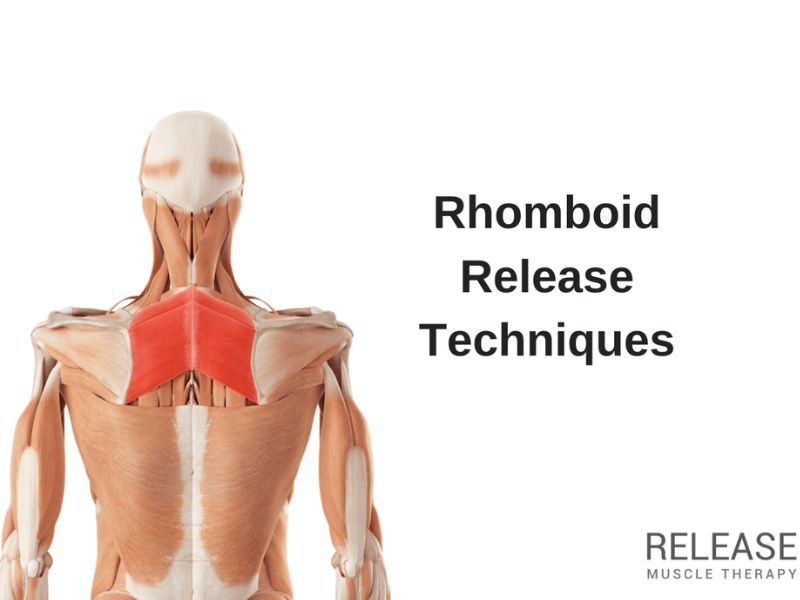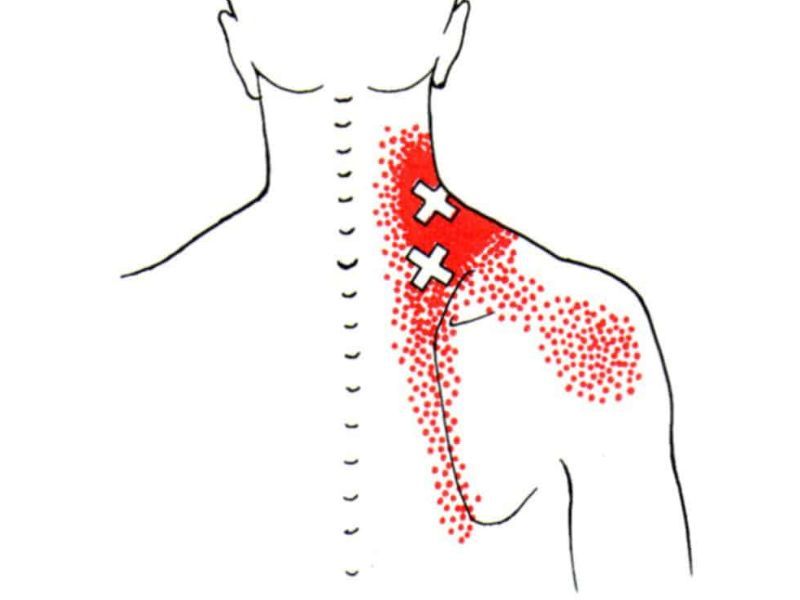Rhomboid Myofascial Release Techniques | Trigger Points

The rhomboid muscles form a muscle group that links your shoulder blades to your spine. They enable shoulder movement, arms lifting, and keeping your posture in check.
However, these muscles can sometimes develop trigger points, leading to discomfort and stiffness in your upper back, neck, and shoulders. This blog post will dive into rhomboid trigger points, their identification, and self-release techniques to ease these pains.

Rhomboid Muscle – Anatomy And Function
The rhomboid comprises two muscle groups( the rhomboid minor and the rhomboid major muscles). These muscles are in between your shoulders and spine and have fibers running diagonally downward from the thoracic vertebrae’s spinous processes to the scapula’s inner border, the shoulder blade’s inside border. The rhomboid muscles’ function is to stabilize the scapula. It helps perform various shoulder girdle movements, such as:
- Scapular adduction: Bringing the shoulders closer to the spine,
- Scapular elevation: Lifting the shoulders and
- Scapular downward rotation: Turning the shoulder blades down.
These movements are essential for reaching, pulling, pushing, and throwing. The rhomboid muscle group collaborates with other upper back muscles, like the trapezius, levator scapulae, and serratus anterior, to coordinate the motion and positioning of the shoulder blades.
Trigger Points in Rhomboid Muscles

Image reference: David G. Simons, Janet G. Travell, Lois S. Simons. Myofascial Pain and Dysfunction: The Trigger Point Manual
Rhomboid trigger points are a common occurrence, affecting individuals across various age groups and professions. These trigger points manifest along the inner border of the scapula, near the spine, or within the midsection of the rhomboid muscles. They can give rise to discomfort in the mid-upper back, often felt between the shoulder blades or along the thoracic spine.
The pain stemming from rhomboid trigger points can manifest in diverse ways, including sharp, dull, burning, or throbbing sensations varying in intensity and frequency. This discomfort may even radiate to other body areas, such as the chest, arm, or head. The referred pain can mimic symptoms of heart attack or migraines.
Trigger points can also occur in other muscle groups, including the pectoralis major, trapezius, levator scapulae, latissimus dorsi, scalenes, and infraspinatus muscles.
Symptoms Associated with Rhomboid Trigger Points
Symptoms linked to rhomboid trigger points include:
- Pain and stiffness in the upper back, between the shoulders, or along the thoracic spine.
- Difficulty moving the shoulders, lifting the arms, or reaching overhead.
- Pain, tightness, or pressure in the chest, especially on the left side.
- Poor posture, including rounded shoulders, forward head, or hunched back.
- Trigger points in the upper trapezius muscles can radiate pain to the temple, cause a headache behind the eye, or pain in the back of the neck.
- Pain, numbness, tingling, or weakness in the arm, particularly in the fourth and fifth fingers.
Causes and Treatment Options for Rhomboid Muscle Pain
Various factors can contribute to the development of these trigger points, including:
- Poor or incorrect posture, especially sitting hunched at your computer for a long time.
- Repetitive or strenuous trigger point activity that involves the shoulders, such as rowing, throwing, or lifting.
- Poor sleep patterns.
- Trauma or injury to the upper back or neck.
- Tight pectoralis muscles pull the shoulder forward, causing a stretch of the middle trapezius muscle.
The treatment options for rhomboid active trigger points depend on the severity and duration of the symptoms—some of the common treatment options and what they offer.
- Massage therapy offers muscle relaxation, trigger point release, and enhanced blood flow and oxygen delivery to the affected tissue.
- Trigger point therapy entails the application of targeted pressure directly on the trigger points. You can do this manually or with specialized tools like a cane or a knob, effectively deactivating the trigger points and easing pain.
- Dry needling involves inserting thin needles into the trigger points, either by a therapist or by yourself, to stimulate the muscle and release the trigger points.
- Heat therapy helps warm the muscles, increase blood circulation, and ease pain and stiffness.
- Cold therapy can help reduce inflammation, numb pain, and prevent swelling.
- Stretching helps relax the muscles and improves flexibility.
- Rhomboid Exercise can help strengthen the muscles, improve posture, and prevent the recurrence of trigger points.
Differential Diagnosis for Rhomboid Trigger Points
Rhomboid trigger points can cause pain and symptoms that can be confused with other conditions, such as:
- Angina: Can cause chest pain, triggered by physical or emotional stress, and relieved by rest or medication.
- Cervical Radiculopathy: Nerve root compression in the cervical spine can cause pain, numbness, and tingling along the affected nerve pathway. These symptoms resemble those seen in rhomboid trigger points.
- Scapular dyskinesis: Occurs when your shoulder blade doesn’t move or position itself correctly during shoulder movements. This can lead to shoulder pain, instability, and weakness. Their trigger points can refer pain to the rhomboid area.
- Rotator Cuff Tendinopathy: Inflammation or degeneration of the rotator cuff tendons, which stabilize the shoulder joint, can refer pain to the rhomboid area.
- Thoracic Outlet Syndrome: Compression of the nerves and blood vessels in the thoracic outlet, the space between the collarbone and first rib, can cause pain, numbness, and tingling. The pain may occur in the neck, shoulders, and arms.
Consult your doctor or a qualified therapist for a detailed examination to rule out these conditions.
How To Self-Treat Rhomboid Trigger Point
There are several ways to self-treat rhomboid trigger points at home, such as:
Stretching the Rhomboid Muscle.
- Lower neck and upper back stretch.
- Start by standing or sitting with proper posture.
- Interlace your fingers in front of your chest.
- Begin by gently extending your arms away from your chest, rounding your upper back, and bringing your chin toward your chest.
- Hold this stretch for 15-30 seconds, then gradually ease back to your initial position.
- Repeat this stretch 2-4 times for optimal results.
- Doorway stretch:
- Position yourself in a doorway, extending your arms outward and placing your hands on the door frame.
- Gently incline your body forward until you sense a stretch in your chest and shoulders.
- Maintain this position for 15-30 seconds, then gradually return to your initial stance.
- Repeat this sequence 2-4 times.
Exercising the Rhomboid Muscles
- Rear delt flyes:
- Stand with your feet hip-width apart and bend forward at the waist until you are almost parallel to the floor.
- Hold a dumbbell in each hand, palms facing each other.
- Bend your elbows so that your forearms are parallel to the floor.
- Raise your arms to the sides until they parallel the floor.
- Lower them back down to your starting position.
- Repeat 10-12 times.
- Scapular retraction:
- Stand with your feet hip-width apart and hold your arms to the sides, palms facing down.
- Squeeze your shoulder blades together and retract them towards your spine.
- Hold for a few seconds, then relax.
- Repeat 10-12 times.
- Front raise:
- Stand with your feet hip-width apart and hold a dumbbell in each hand, palms facing down.
- Raise your arms out until they are level with your shoulders.
- Lower them back down to your sides.
- Repeat 10-12 times.
Use these self-treatment methods for your rhomboid muscles when necessary, but avoid overdoing it. Begin with lighter weights and gradually increase as your strength improves. Always warm up before exercising and cool down afterward. If you feel any pain, stop and consult a medical professional.
Wrapping up
Rhomboids trigger points are common and can cause discomfort in your upper back and shoulders. However, you can identify and self-treat them at home with some simple techniques. If you have a concern, seek advice from your doctor or a qualified therapist.
Sam Visnic
I’ve spent my life studying the fundamental aspects of human health with a focus on movement and clinical massage therapy. In a world of specialists, surgical procedures, drugs and quick fix remedies, I’m committed to finding and developing strategies that help people stuck at the “gap”. Over the last 20 years I’ve studied dozens of systems and methodologies for uncovering the root cause of aches and pains, along with postural and movement issues. Pain science, the art and science of hands-on soft tissue massage techniques, myofascial release, and coaching movement is essential in my practice. Integrating different methods but above all deciphering WHEN to use different techniques with different people and situations, along with integration of movements that people want to be able to do again is the key to long term success with my incredible track record with clients. Understanding the various elements that contribute to conditions and the power of communication and education makes my Release Muscle Therapy program separate from other hands-on therapy approaches.
Blogs You May Be Interested In
Categories
-
Deep Gluteal Pain Syndrome
-
Deltoids
-
Fallbrook
-
Foam Rolling
-
Glutes
-
Hamstrings
-
Hypnosis For Pain
-
Lats
-
Levator Scapulae
-
Lifestyle
-
Massage Therapy
-
Mobility
-
Movement and Exercise
-
Murrieta
-
Muscles
-
Nutrition
-
Obliques
-
Pain
-
Pectorals
-
Piriformis
-
Plantar Fasciitis
-
Product Review
-
Psoas
-
Quadratus Lumborum
-
Quadriceps
-
Rhomboids
-
Serratus Anterior
-
SI Joint
-
Sternocleidomastoid
-
Stretching
-
Subscapularis
-
Temecula
-
TMJ
-
Trapezius
-
Uncategorized
















